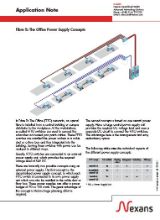- About Aginode
- Data Networks
- Telecom Infrastructure
- Products
-
Resources
- Resources
- Documentation
- Blog
-
Case Studies
- Overview
- Innoasis development in Norway
- Eemsdelta Campus
- Hotelschool The Hague
- Emergency covid hospital, Hong Kong
- Société du Grand Paris
- Centrin Datacentres
- Airbus
- Athens Historic City Hall
- Pinewood Studios
- Goethe University Frankfurt
- Denmark New University Hospital
- University of Toulouse
- CHM Maubeuge: a model for future-ready hospitals
- Webinars
- Software Tools
- Warranty
- Newsroom
- Search
- Contact us
- Compare
- Sign in
Office & Enterprise
Powering FTTO while supporting end-user devices and future applications


Enabling current and coming generations of PoE in a scalable way
The LAN as an energy network
The Fibre To The Office (FTTO) concept offers many advantages in the area of flexibility, bandwidth and redundancy. However, when planning a network, we need to take far more aspects into account than these. Because today's LAN infrastructures increasingly serve as energy networks connecting an ever-increasing number of compatible devices, planning for efficient and safe power supply is becoming increasingly important. A new Application Note (download below) offers planners, consultants and network administrators insight into various solutions for power supply concepts in an FTTO network, as well as design considerations and tips & tricks.
A closer look at FTTO
FTTO is a decentralized infrastructure concept that combines the benefits of fibre and twisted pair cabling. Unlike traditional structured cabling, FTTO uses fibre optic cables in both vertical and horizontal cabling, while twisted-pair patch cords are used to span short distances and connect end devices. FTTO switches provide the intelligent link between the fibre and the twisted-pair cable, taking the converted Ethernet signal from the fibre to the terminal, via standard RJ45 patch cables. Using twisted-pair patch cords makes it possible to provide ‘Power over Ethernet’ (PoE) to end devices: a single cable provides data throughput while also providing power, typically 15 to 30 watts for traditional office applications. Many active network components such as VoIP phones, surveillance cameras, thin clients or Wi-Fi access points support PoE. Consecutive generations are capable of supporting higher wattages: PoE (Type 1, IEEE 802.3af up to 15.5W), PoE + (Type 2, IEEE 802.3at up to 30W) and PoE ++ (Type 3 and Type 4, IEEE 802.3bt up to 60W and 90W).
The power consumption of an FTTO switch can reach 120 watts when using PoE + which can supply power to multiple devices. Although PoE+ and higher are associated with higher temperature in cables and bundles, this is not an issue with FTTO. Depending on requirements and layouts, the power concept can be optimised to provide appropriate voltage levels in different parts of the network.
Different approaches to powering switches
230V AC: The easiest way to power FTTO switches is by connecting them directly to the 230V power grid. However current-carrying cables should be sufficiently dimensioned for the maximum expected load and be equipped with standard-compliant protection. However, the switches cannot support PoE service with this power supply concept so devices will require separate adapters. To ensure operation in the event of a power outage, introducing central UPS (uninterruptible power supply) modules is suggested.
54V DC: AC voltage is transformed into a lower DC voltage (48-57V DC) with an external power supply requiring a switch. In this way, FTTO switches can supply power over PoE. Power supply can be designed in a centralized or decentralized configuration with redundancy built in to ensure fail-safe operation. (These approaches are described in some detail in the Whitepaper, along with benefits, challenges and hardware requirements). A centralized approach offer managed redundancy, monitoring and control but this approach does require more extensive planning and adds some cost. A decentralized approach using individual supplies is the most efficient way of transmitting energy, at a lower cost, and makes planning easier. However, there are limits with regard to Wattage, redundancy and monitoring. A decentralised ‘supply island’ offers similar advantages and challenges, while introducing a high level of scalability – although this requires additional space.
No ‘one size fits all’ solution
FTTO concepts can be planned with a variety of modern, efficient power supply technologies. Each approach has its advantages and disadvantages. Because requirements may vary greatly, there is no overall ‘better’ choice applicable to all user cases. However, with the appropriate know-how and a targeted approach, planning errors and mistakes can be avoided. First and foremost, the maximum load on the overall system, the hedge and the resulting losses should be checked to make the right choice of components. In addition, of course, the efficiency of the power supply and the associated costs should be determined. Of course, our experts are always happy to discuss your specific situation and any requirements you may have!
Documentation
Categories
Our websites
Select your country to find our products and solutions
-
Africa
- Africa
- Ghana
- Ivory Coast
- Morocco
- North West Africa
- Americas
- Asia
- Europe
- Oceania

